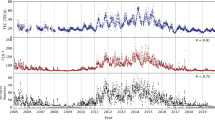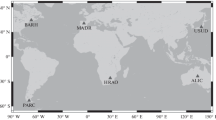Abstract
The Total Electron Content (TEC) prediction performances of the empirical IRI model and IRI-PLAS model were investigated by comparing the GPS-based TEC values provided by the IONOLAB group. TEC values were obtained on equinox (March 21 and September 23) and solstice (June 21, and December 21) days in low (2009), medium (2012) and high (2015) solar activity periods at Istanbul, Turkey. The prediction performances of the models were statistically analyzed based on the differences between the GPS-TEC and the empirical models, considering the maximum and minimum deviations, the correlation analysis and the root mean square error (RMSE). As a result of the investigation, it is seen that the empirical models have similar predictive performances when the plasmaspheric effects are neglected, and the IRI-PLAS estimations are generally a little closer to the observed GPS-TEC values than all options of IRI-2016 model. Also, it can be said that “IRI2001”, one of the IRI-2016’s “topside” options, can make better predictions than other options and “IG” solar proxy option of IRI-PLAS model is a more appropriate option than the others in TEC calculations over Istanbul, Turkey.



Similar content being viewed by others
References
Alçay, S., Oztan, G., Selvi, H.Z.: Comparison of IRI_PLAS and IRI_2012 model predictions with GPS-TEC measurements in different latitude regions. Ann. Geophys. 60(5), 0549 (2017)
Amin, M.M.: Influence of lightning on electron density variation in the ionosphere using WWLLN lightning data and GPS data, University of Cape Town (2015)
Ansari, K., Corumluoglu, O., Panda, S.K.: Analysis of ionospheric TEC from GNSS observables over the Turkish region and predictability of IRI and SPIM models. Astrophys. Space Sci. 362(4), 65 (2017)
Arikan, F., Nayir, H., Sezen, U., Arikan, O.: Estimation of single station interfrequency receiver bias using GPS-TEC. Radio Sci. 43(4), RS4004 (2008)
Arikan, F., Sezen, U., Gulyaeva, T., Cilibas, O.: Online, automatic, ionospheric maps: IRI-PLAS-MAP. Adv. Space Res. 55(8), 2106–2113 (2015)
Atıcı, R., Sağır, S.: The effect of QBO on foE. Adv. Space Res. 60(2), 357–362 (2017)
Atıcı, R., Güzel, E., Canyılmaz, M., Sağır, S.: The effect of lightning-induced electromagnetic waves on the electron temperatures in the lower ionosphere. Kuwait J. Sci. Eng. 43, 143–149 (2016)
Basu, S., Basu, S., Valladares, C., Yeh, H.C., Su, S.Y., MacKenzie, E., Doherty P, .: Ionospheric effects of major magnetic storms during the International Space Weather Period of September and October 1999: GPS observations, VHF/UHF scintillations, and in situ density structures at middle and equatorial latitudes. J. Geophys. Res. Space Phys. 106(A12), 30389–30413 (2001)
Bilitza, D.: International reference ionosphere 2000. Radio Sci. 36(2), 261–275 (2001)
Bilitza, D., McKinnell, L.-A., Reinisch, B., Fuller-Rowell, T.: The international reference ionosphere today and in the future. J. Geod. 85(12), 909–920 (2011)
Bilitza, D., Brown, S.A., Wang, M.Y., Souza, J.R., Roddy, P.A.: Measurements and IRI model predictions during the recent solar minimum. J. Atmos. Sol.-Terr. Phys. 86, 99–106 (2012)
Bilitza, D., Altadill, D., Zhang, Y., Mertens, C., Truhlik, V., Richards, P., Reinisch B, .: The International Reference Ionosphere 2012—a model of international collaboration. J. Space Weather Space Clim. 4, A07 (2014)
Bilitza, D., Altadill, D., Truhlik, V., Shubin, V., Galkin, I., Reinisch, B., Huang, X.: International Reference Ionosphere 2016: from ionospheric climate to real-time weather predictions. Space Weather 15(2), 418–429 (2017)
Bittencourt, J.A.: Fundamentals of Plasma Physics. Springer, Berlin (2013)
Çetin, K., Özcan, O., Korlaelçi, S.: The interaction between stratospheric monthly mean regional winds and sporadic-E. Chin. Phys. B 26(3), 039401 (2017)
Doherty, P., Coster, A.J., Murtagh, W.: Space weather effects of October–November 2003. GPS Solut. 8(4), 267–271 (2004)
Ezquer, R.G., Scidá, L.A., Orué, Y.M., Nava, B., Cabrera, M.A., Brunini, C.: NeQuick 2 and IRI Plas VTEC predictions for low latitude and South American sector. Adv. Space Res. 61(7), 1803–1818 (2018)
Fagundes, P.R., Cardoso, F., Fejer, B., Venkatesh, K., Ribeiro, B., Pillat, V.: Positive and negative GPS-TEC ionospheric storm effects during the extreme space weather event of March 2015 over the Brazilian sector. J. Geophys. Res. Space Phys. 121(6), 5613–5625 (2016)
Gulyaeva, T.: International standard model of the Earth’s inosphere and plasmasphere. Astron. Astrophys. Trans. 22(4–5), 639–643 (2003)
Gulyaeva, T., Bilitza, D.: Towards ISO standard Earth ionosphere and plasmasphere model. In: New Developments in the Standard Model. NOVA Publishers, New York (2012). https://www.novapublishers.com/catalog/product_info.php?products_id=35812
Gulyaeva, T.L., Huang, X., Reinisch, B.W.: Plasmaspheric extension of topside electron density profiles. Adv. Space Res. 29(6), 825–831 (2002)
Gulyaeva, T., Arikan, F., Sezen, U., Poustovalova, L.: Eight proxy indices of solar activity for the International Reference Ionosphere and Plasmasphere model. J. Atmos. Sol.-Terr. Phys. 172, 122–128 (2018)
Karatay, S., Cinar, A., Arikan, F.: Ionospheric responses during equinox and solstice periods over Turkey. Adv. Space Res. 60(9), 1958–1967 (2017)
Laštovička, J.: Forcing of the ionosphere by waves from below. J. Atmos. Sol.-Terr. Phys. 68(3–5), 479–497 (2006)
Maltseva, O., Mozhaeva, N., Nikitenko, T.: Comparative analysis of two new empirical models IRI-Plas and NGM (the Neustrelitz Global model). Adv. Space Res. 55(8), 2086–2098 (2015)
Nayir, H., Arikan, F., Arikan, O., Erol, C.: Total electron content estimation with Reg-Est. J. Geophys. Res. Space Phys. 112(A11), A11313 (2007)
Okoh, D., Eze, A., Adedoja, O., Okere, B., Okeke, P.: A comparison of IRI-TEC predictions with GPS-TEC measurements over Nsukka, Nigeria. Space Weather 10(10), S10002 (2012)
Pasko, V., Inan, U., Bell, T., Taranenko, Y.N.: Sprites produced by quasi-electrostatic heating and ionization in the lower ionosphere. J. Geophys. Res. Space Phys. 102(A3), 4529–4561 (1997)
Pulinets, S., Boyarchuk, K., Hegai, V., Kim, V., Lomonosov, A.: Quasielectrostatic model of atmosphere-thermosphere-ionosphere coupling. Adv. Space Res. 26(8), 1209–1218 (2000)
Sağır, S., cıR, A., Özcan, O., Yüksel, N.: The effect of the stratospheric QBO on the neutral density of the D region. Ann. Geophys. 58(3), 0331 (2015)
Sezen, U., Arikan, F., Arikan, O., Ugurlu, O., Sadeghimorad, A.: Online, automatic, near-real time estimation of GPS-TEC: IONOLAB-TEC. Space Weather 11(5), 297–305 (2013)
Sezen, U., Gulyaeva, T.L., Arikan, F.: Performance of solar proxy options of IRI-Plas model for equinox seasons. J. Geophys. Res. Space Phys. 123(2), 1441–1456 (2018)
Yiğit, E., Medvedev, A.S.: Internal wave coupling processes in Earth’s atmosphere. Adv. Space Res. 55(4), 983–1003 (2015)
Yiğit, E., Knížová, P.K., Georgieva, K., Ward, W.: A review of vertical coupling in the atmosphere–ionosphere system: effects of waves, sudden stratospheric warmings, space weather, and of solar activity. J. Atmos. Sol.-Terr. Phys. 141, 1–12 (2016)
Zakharenkova, I., Cherniak, I.V., Krankowski, A., Shagimuratov, I.: Vertical TEC representation by IRI 2012 and IRI Plas models for European midlatitudes. Adv. Space Res. 55(8), 2070–2076 (2015)
Author information
Authors and Affiliations
Corresponding author
Rights and permissions
About this article
Cite this article
Atıcı, R. Comparison of GPS TEC with modelled values from IRI 2016 and IRI-PLAS over Istanbul, Turkey. Astrophys Space Sci 363, 231 (2018). https://doi.org/10.1007/s10509-018-3457-0
Received:
Accepted:
Published:
DOI: https://doi.org/10.1007/s10509-018-3457-0




